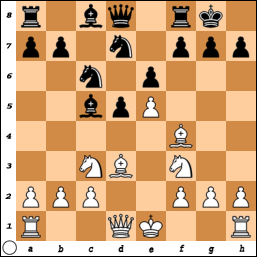Spanton (171) - Luca Buanne (135)
French Classical, Steinitz Variation
1.e4 e6 2.d4 d5 3.Nc3 Nf6 4.e5 Nfd7 5.Nf3
Recommended by Tarrasch, but French Defence gurus like John Watson tend to regard it as harmless, although it has been favoured by attacking players such as Morozevich.
5...c5 6.dxc5
This looks strange but is difficult to avoid. Stockfish10 suggests 6.Ne2!?, which has been played by some grandmasters. Komodo9 suggests 6.Nb5, but flashes red - meaning a mistake - as soon as the move is executed on the board!
6...Bxc5 7.Bd3 Nc6 8.Bf4 0-0?
 |
| No prizes for guessing White's next |
*****
*****
*****
*****
9.Bxh7+ Kxh7 10.Ng5 Kg6 11.Qd3+
This seems clearer than 11.Qg4, when 11...Ndxe5, 11...Ncxe5 and 11...f5 have to be considered.
11...f5 12.Nxe6?!
There was no need to rush this capture.
Objectively better was 12.Qg3, when the engines give best-play as the forcing line 12...Ndxe5 13.Nxe6+ Ng4! 14.Nxd8 Bxf2+ 15.Qxf2 Nxf2 16.Nxc6 Nxh1. After 17.Ne5+ or 17.Nd4, White is the exchange down but should win Black's knight trapped at h1, and Black's d pawn is weak.
My choice has the practical advantage that Black's king remains exposed to attack.
12...Qh4!
Keeping the game going.
12...Ndxe5 transposes to the last note after 13.Qg3+.
13.g3 Qh8 14.Nxf8+ Qxf8 15.Nxd5 Ndxe5 16.Bxe5 Nxe5 17.Nf4+
The engines prefer 17.Qe2, leaving the knight where it is.
17...Kh6
Better was 17...Kh7! The point is that after 18.Qe2 Ng4, White cannot play 19.h3?? (White should choose 19.0-0-0) because 19...Nf2 20.Qh5+ comes to nothing as Black's king finds shelter on g8.
18.Qe2 Ng4 19.0-0-0
Also possible was 19.h3 as 19...Bxf2+?? (correct is 19...Nf6) loses a piece to 20.Kf1.
After the text, Black is doing fine materially - a pair of bishops is roughly equivalent to a rook and two pawns. Indeed he might even be better in the middlegame if his pieces were coordinated. But Black's lag in development and his exposed king mean White has the advantage.
 |
| What should Black play? |
*****
*****
*****
*****
19...Qe7?!
Given all the above, getting the queens off is understandable, but the engines prefer slower play with moves such as 19...Nf6, 19...g6, 19...Kh7 or 19...Qf7.
20.Qxe7 Bxe7 21.Rhe1 Bf6 22.Re8 Kh7
The engines want Black to play 22...Nxf2+!?, although after 23.Rh8+ Kg5 24.Rd2 (24.Rh5+? loses to 24...Kg4, eg 25.Rd2 g5! 26.Rxf2 gxf4 27.Rh7 f3 when the bishops will come into their own) Ne4 25.Rh5+ Kg4 26.Rd3 Nxg3 27.hxg3 White's extra exchange should tell.
23.f3 Nf2?!
23...Ne5 was the obvious move but White is still winning after 24.Nd5 or 24.Nh5.
24.Rf1
Simpler is the natural 24.Rd2, as after 24...Nh1 25.Re1 it is White who is helped by opening the h file with 25...Nxg3 26.hxg3.
24...Bd4 25.Re2 g5 26.Re7+ Kg8 27.Nd5 b5?
This makes things worse, but Black did not have a good move.
28.c3 Bc5 29.Rc7 Nd3+ 30.Kc2 Be6 31.Kxd3 Bxd5 32.Rxc5+ Bc4 33.Rxc4+ bxc4 34.Kxc4 (1-0, 53 moves)
No comments:
Post a Comment